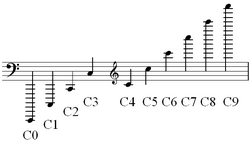Stringed instrument tunings
This is a chart of stringed instrument tunings. Instruments are listed alphabetically by their most commonly known name.
Terminology
A course may consist of one or more strings.
Courses are listed reading from left to right facing the front of the instrument, with the instrument standing vertically. On a majority of instruments, this places the notes from low to high pitch. Exceptions exist:
- Instruments using reentrant tuning (e.g., the charango) may have a high string before a low string.
- Instruments strung in the reverse direction (e.g. mountain dulcimer) will be noted with the highest sounding courses on the left and the lowest to the right.
- A few instruments exist in "right-hand" and "left-hand" versions; left-handed instruments are not included here as separate entries, as their tuning is identical to the right-hand version, but with the strings in reverse order (e.g., a left-handed guitar).
Strings within a course are also given from left to right, facing the front of the instrument, with it standing vertically. Single-string courses are separated by spaces; multiple-string courses (i.e. paired or tripled strings) are shown with courses separated by bullet characters (•).

Pitch: Unless otherwise noted, contemporary western standard pitch (A4 = 440 Hz) and 12-tone equal temperament are assumed.
Octaves are given in scientific pitch notation, with Middle C written as "C4". (The 'A' above Middle C would then be written as "A4"; the next higher octave begins on "C5"; the next lower octave on "C3"; etc.)
Because stringed instruments are easily re-tuned, the concept of a "standard tuning" is somewhat flexible. Some instruments:
- have a designated standard tuning (e.g., violin; guitar)
- have more than one tuning considered "standard" (e.g. mejorana, ukulele)
- do not have a standard tuning but rather a "common" tuning that is used more frequently than others (e.g., banjo; lap steel guitar)
- are typically re-tuned to suit the music being played or the voice being accompanied and have no set "standard" at all (e.g., đàn nguyệt; Appalachian dulcimer)
Where more than one common tuning exists, the most common is given first and labeled "Standard" or "Standard/common". Other tunings will then be given under the heading "Alternates".
A
B
C
D
E
F
G
H
I
J
K
L
M
N
O
P
Q
R
S
T
U
V
W
X
Y
Z
Zither tuning chart
Notes
See also
- Bass guitar tunings
- Guitar tunings
- Plucked string instrument list
- Scale (string instruments)
- Scordatura
- Violin tunings
References
- Brody, David; The Fiddler's Fakebook: The Ultimate Sourcebook For The Traditional Fiddler; Music Sales America (1992).ISBN 0825602386
- Dearling, Robert; Stringed Instruments; Chelsea House Publishing (2000).ISBN 0791060926
- Hanson, Mark; The Complete Book of Alternate Guitar Tunings; Music Sales America (1995).ISBN 0936799137
- Marcuse, Sibyl; Musical Instruments: A Comprehensive Dictionary; W. W. Norton & Company (1975).ISBN 0393007588
- Piston, Walter; Orchestration; W. W. Norton & Company (1955).ISBN 0393097404
- Randell, D. M. (editor); Harvard Dictionary of Music, 4th Edition; Belknap Press of Harvard University Press (2003).ISBN 0674011635